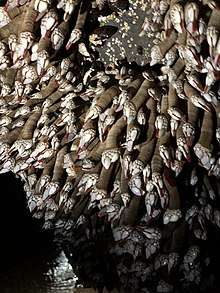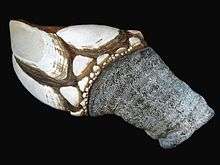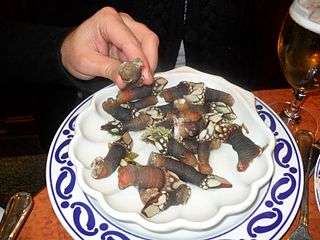Pollicipes pollicipes
Pollicipes pollicipes, known as the goose neck barnacle, goose barnacle or leaf barnacle is a species of goose barnacle, also well known under the taxonomic synonym Pollicipes cornucopia. It is closely related to Pollicipes polymerus, a species with the same common names, but found on the Pacific coast of North America,[4] and to Pollicipes elegans a species from the coast of Chile.[2] It is found on rocky shores in the north-east Atlantic Ocean and is prized as a delicacy, especially in the Iberian Peninsula.[5]

| Pollicipes pollicipes | |
|---|---|
 | |
| Scientific classification | |
| Kingdom: | |
| Phylum: | |
| Subphylum: | |
| Class: | |
| Infraclass: | |
| Order: | |
| Family: | |
| Genus: | |
| Species: | P. pollicipes |
| Binomial name | |
| Pollicipes pollicipes | |
| Range of P. pollicipes shown in red | |
| Synonyms | |
Distribution
Pollicipes pollicipes is chiefly distributed from 48°N to 28°N, along the coasts of France, Spain (including the Canary Islands), Portugal, Morocco, and south to Senegal.[5] A further population disjunctly located around the tropical Cape Verde Islands at about 16°N has been recently described as a new species, Pollicipes caboverdensis.[6] The periphery of the species' range also extends as far north as the British Isles, with outlying populations on the south coast of England and possibly in southwestern Ireland,[3] although there are no recent records there.[7] The species is present, but rare, in the Mediterranean Sea.[8] It is possible that the outlying populations are not self-sustaining, being instead maintained by immigration of larvae from self-sustaining core populations.[9]
In December 2016, a driftwood covered with gooseneck barnacles appeared in a beach in New Zealand, prompting a discussion on what it might be.[10] They or a similar species is served in the coast of Ecuador in the province of Manabi, where they have them as a typical dish in very specific restaurants in Puerto Lopez or Salango.
Ecology
Pollicipes pollicipes grows in groups on rocks, as well as on the hulls of shipwrecks and on driftwood.[3] It is a filter feeder, living on particles that it can glean from the water passing over its extended cirri; these possess a complex assortment of setae, enabling P. pollicipes to have a varied diet, including diatoms, detritus, large crustaceans, copepods, shrimp and molluscs.[11]
The larvae pass through seven free-swimming stages (six nauplii and one cypris) over the course of at least a month.[12] After this time, they settle into the adult, sessile form.
P. pollicipes is harvested for consumption in many parts of its range, mostly for the Spanish market, where (marketed as percebe gallego) it may sell for as much as €90 per kilogram.[5] As a result, the species is thought to be in decline.[8] It is harvested manually, and archaeological evidence suggests that the species has been harvested in this way for over 10,000 years.[13]

References
| Wikimedia Commons has media related to Pollicipes pollicipes. |
- Alan Southward (December 21, 2004). "Pollicipes pollicipes (Gmelin, 1789)". European Register of Marine Species. MarBEF Data System.
- Charles Darwin (1851). A monograph on the sub-class Cirripedia, with figures of all the species. Ray Society.
- M. K. S. Barnes (February 10, 2009). "A stalked barnacle – Pollicipes pollicipes". Marine Life Information Network for Britain & Ireland. Marine Biological Association of the United Kingdom. Archived from the original on December 23, 2012.
- Melissa McFadden, Hans Helmtetler & Dave Cowles (2007). "Mitella polymerus (Sowerby, 1833)". Walla Walla University. Archived from the original on 2012-02-13.
- J. Molares & J. Freire. "Fisheries and management of the goose barnacle Pollicipes pollicipes of Galicia (NW Spain)".
- J. N. Fernandes; T. Cruz & R. Van Syoc (2010). "Pollicipes caboverdensis sp. nov. (Cirripedia: Lepadomorpha), an intertidal barnacle from the Cape Verde Islands" (PDF). Zootaxa. 2557: 29–38. doi:10.11646/zootaxa.2557.1.3.
- Dan Minchin (2007). "A checklist of alien and cryptogenic aquatic species in Ireland" (PDF). Aquatic Invasions. 2 (4): 341–366. doi:10.3391/ai.2007.2.4.4. Archived from the original (PDF) on 2009-02-19. Retrieved 2009-02-17.
- Teresa Cruz (2000). Biologia e ecologia do percebe Pollicipes pollicipes (Gmelin, 1790) no litoral sudoeste português (PDF) (in Portuguese). Universidade de Évora. Archived from the original (PDF) on 2009-12-18.
- Thomas Carefoot (1977). Pacific Seashores. Seattle: University of Washington Press. ISBN 0-88894-121-8.
- M.J.Dilonardo (December 13, 2016). "Curious 'castaway' makes imaginations run wild". Archived from the original on December 14, 2016. Retrieved December 14, 2016.
- B. K. K. Chan, A. Garm & J. T. Høeg (2008). "Setal morphology and cirral setation of thoracican barnacle cirri: adaptations and implications for thoracican evolution". Journal of Zoology. 275 (3): 294–306. doi:10.1111/j.1469-7998.2008.00441.x. Archived from the original on 2012-06-05.
- J. Molares, F. Tilves & C. Pascual (1994). "Larval development of the pedunculate barnacle Pollicipes cornucopia (Cirripedia: Scalpellomorpha) reared in the laboratory". Marine Biology. 120 (2): 261–264. doi:10.1007/BF00349686.
- Esteban Álvarez-Fernández, Roberto Ontañón-Peredo & José Molares-Vila (2010). "Archaeological data on the exploitation of the goose barnacle Pollicipes pollicipes (Gmelin, 1790) in Europe". Journal of Archaeological Science. 37 (2): 402–408. doi:10.1016/j.jas.2009.10.003.